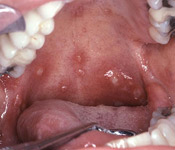 Mouth ulcers are open sores or lesions inside the mouth. There are several types and can be caused by a variety of disorders. Many are benign and go away on their own without treatment. If they don’t go away after a couple of weeks, they should be checked by a doctor.
Mouth ulcers are open sores or lesions inside the mouth. There are several types and can be caused by a variety of disorders. Many are benign and go away on their own without treatment. If they don’t go away after a couple of weeks, they should be checked by a doctor.
Types of Mouth Ulcers
Canker Sores – The most common mouth ulcers are canker sores, which are white or yellow and may be surrounded by a bright red area. The can be extremely painful and annoying, but usually go away on their own in about a week to 10 days. They are found only on the inside of the mouth, such as the cheek, tongue, gum, inner lip and soft palate. Their cause is unknown, but may be triggered by stress, eating acidic foods such as tomatoes or pineapple, food allergies or sensitivities, mild trauma to the mouth such as overly aggressive tooth-brushing or they may be tied to the menstrual cycle as they are most prevalent in women. In some cases there may be an underlying immune system issue. Canker sores are nor contagious and do not appear to be caused by bacteria or viruses, although they can run in families.
Gingivostomatitis – This is an infection of the mouth and gums that may be caused by a virus or bacteria. It is fairly common and is especially common in children. Sometimes it occurs as a side effect of the herpes simplex virus type 1 (cold sore) and it can also occur in people who practice poor oral hygiene. Common symptoms include fever, bad breath, general feeling of malaise, and very painful sores on the inside of cheeks or gums to the point where eating is difficult. Your doctor can diagnose gingivostomatitis based on visual examination and the symptoms mentioned above. Sores should improve or disappear in 2 to 3 weeks, but as they heal it is important to maintain good oral hygiene and brush the gums gently to keep good bacteria in the mouth. If symptoms are especially severe, antibiotics or a medicated mouth rinse may be prescribed. There are over-the-counter numbing agents such as benzocaine that can help reduce discomfort of these mouth ulcers.
Fever Blisters – Also known as cold sores or herpes simplex virus type 1, fever blisters usually occur on the outside of the mouth including the lips, chin cheeks, or in the nostrils. Fever blisters, or cold sores, have been around for thousands of years. An estimated 40-80 million Americans have had at least one outbreak in their lifetime. They are caused by the virus herpes simplex and are highly contagious when blisters are present. The fluid-filled blisters may be accompanied by fever, swollen neck glands and general achiness, most commonly with the first outbreak. After a week or so the blisters generally collapse and a yellowy crust forms. The sore usually heals within a couple of weeks without scarring. The virus stays in the body, however, and may remain inactive for years or be triggered by stress, illness, fever, or exposure to sunlight. Unfortunately there is no cure at present for fever blisters, but there are over-the-counter numbing ointments that can help relieve the discomfort.
Leukoplakia – These are whitish patches of excess cell growth on the inside of the mouth — cheeks, gums or tongue. They may be gray or white and thick and slightly raised with a hard surface. These patches are common among smokers and tobacco chewers. They may also result from irritations such as ill-fitting dentures. While Leukoplakia is usually harmless, it is important to see your doctor if you suspect you have it. You should avoid smoking and tobacco products as well as alcohol. These mouth ulcers develop slowly and while not as immediately painful as canker sores, may become sensitive to spicy or acidic foods, touch or other irritation such as tooth-brushing.
Prevention
Practicing good oral hygiene may help prevent some types of mouth ulcers and complications. It is good practice to brush your teeth at least twice daily, floss daily, and get regular dental cleanings and check- ups. If you develop a mouth ulcer that doesn’t go away within 2-3 weeks or gets works, see your doctor.